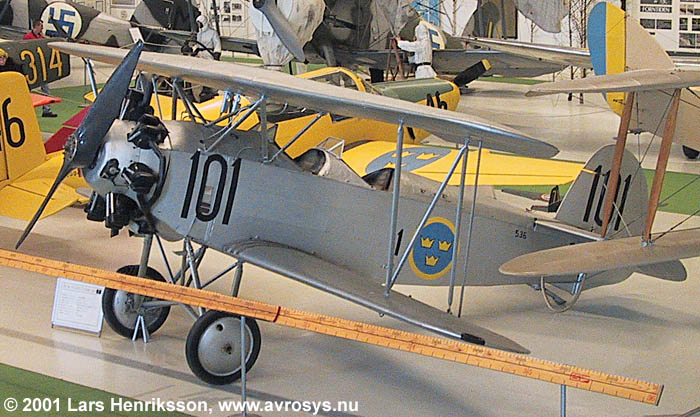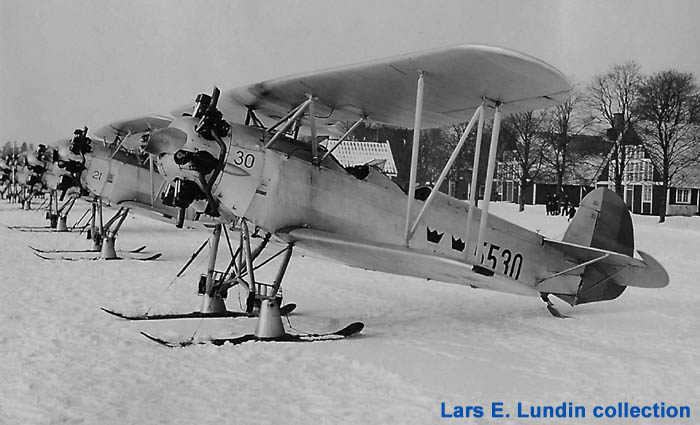|
|
||
| Sk 10 - Raab-Katzenstein RK-26 Tigerschwalbe (1932-1945) | ||
|
|
Page 1(2) |
|
|
|
||
 |
||
|
In the autumn of 1930, Gerhard
Fieseler, then World Champion of Aerobatics, visited the
Air
Force Flight Academy
(F 5) at Ljungbyhed. Fieseler, who later designed the famous
STOL aircraft Fieseler Storch (S 14), made an
impressive show with his Raab-Katzenstein RK 26 Tigerschwalbe, an
one-seated aeroplane designed for aerobatics. Gerhard
Fieseler arrived to F 5
just at the right time. The
Air
Force Flight Academy needed badly an aircraft for
advanced training. Fieseler had been invited to Ljungbyhed by the chief
flying instructor Nils Söderberg, later Major-General (Air
Vice-Marshal) of the Air Force. By recommendation of Nils Söderberg,
the Air Board made an inquiry to the Swedish aeroplane manufacturer ASJA
at Linköping. ASJA, which had secured the rights for license
production, bought a German-built Tigerschwalbe. The aircraft were put
into the civil register as SE-ACO and was rented to the War Flying
School. At the school it was tested by the flying instructors, who found
the aircraft suitable as the missing advanced trainer. In February 1932, ASJA got an
order of 25 aircraft. The Air Force designation became Sk
10 and the individual aircraft got the Air Force numbers 521-545.
The design was partly changed compared to the German Tigerschwalbe. The
most important alteration was of course that the aircraft was changed to
a two-seater with dual command. The original Tigerschwalbe was fitted
with an 175 hp Armstrong Siddeley Lynx engine. The Swedish variant got
an 260 hp Walter Castor 1A, of course stronger but also heavier. The
wings were reinforced. Together with the heavier Swedish-made plywood,
their weight increased by 60 kg. Also the tail part was reinforced.
Totally, the ASJA-built Tigerschwalbe was
nearly 200 kg heavier than SE-ACO. This fact of course changed
the flying performance. The 25 Sk 10:s were delivered
from October 1932 to May 1934. The
Sk 10 became very controversial. Before the first half of the batch was
delivered, two of the aircraft got into uncontrollable spin when flying
inverted. This resulted in both cases in fatal crashes. These accidents
started the ”Sk 10 Affair”, which engaged the newspapers of the
entire Sweden. The Sk 10 was stamped as highly dangerous due to faulty
design.. The Air Force was divided into two parties. An order which
prohibited aerobatics was issued for the aircraft, but a commission of
inquiry revoked this order. Charles Lindbergh, who visited Sweden in
1933, tested the Sk 10 and performed advanced aerobatics. His opinion
was ”all right”. One Sk 10 was flown to the Royal Aircraft Establishment at
Farnborough for tests. The report from 1934 brought it out clearly
that the aircraft was hard to handle, but as the British and the
Swedish training programmes were totally different, the report was of
little value. But as time passed, the Sk 10
were accepted for its
intended mission. It was a machine which separated the wheat from the
chaff. Of the 25 delivered
aircraft, 18 were written off due to crashes. One Sk 10, the only remaining
Tigerschwalbe in the world, is preserved at Flygvapenmuseum
(photo above). The aircraft was delivered in January 1934 and written off in
December 1944. SwAF/n 536, c/n 20. As seen on the picture below, the Sk 10 could be equipped with skis. This photo below from the large archive of Lars E. Lundin, Västervik, shows a row of Sk 10 with SwAF/n 530 and 521 nearest to the camera. These aircraft from Ljungbyhed had just made a stopover at Malmen. The final destination is Grangärde in the province of Dalarna, where winter exercises will take place. Length: 6,55 m. Span: 8,40 m. MTOW 1.136 kg. Max. speed: 191 km/h.
|
||
 |
||
|
|
||
|
|
||
|
|
||
|
© Lars Henriksson |
|
Updated 2010-07-10 |
|
|
||